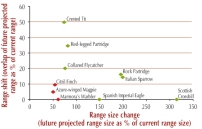
Results from studies by BirdLife and othersaround the world show that, on average,species are projected to face 10-30% declinesin their geographic range sizes, with 30-70% of their current distributions projected to become unsuitable by the end ofthe 21st century. Species that are likely to experience a substantial proportional range loss and shift (with low overlap between present and projected future range) as a consequence of climate change are of particular concern.

Climate change is already shifting the distribution of bird species across the globe (Zuckerberg et al. 2009, Auer and King 2014, Environmental Protection Agency 2014, Virkkala & Lehikoinen 2014, Gillings et al. 2015), and these changes are expected to continue throughout the century (Huntley et al. 2008, Barbet-Massin et al. 2009, Hole et al. 2009, Araujo et al. 2011, Bagchi et al. 2013, Langham et al. 2015).
We have collated the results of seven studies from across the planet to show that on average, species are expected to experience 10-30% declines in their geographic range sizes, with 30-70% of their current distributions projected to become unsuitable by the end of the 21st century (Huntley et al. 2008, Hole et al. 2009, Barbet-Massin et al. 2009, Doswald et al. 2009, Huntley et al. 2012, Bagchi et al. 2013, Langham et al. 2015).
There is however much variation across and within regions, with bird species in North America, on average, experiencing increases in range sizes (Langham et al. 2015). The McCown’s Longspur Rhynchophanes mccownii for example, is predicted to lose 100% of its summer range by 2080, but a 167% increase in winter range, whilst the American Avocet Recurvirostra americana, will lose as much as 96% of their summer range and experience a 33% increase in winter range (Langham et al. 2015, National Audubon 2015).
Species in Europe are generally expected on average to lose most range extent and overlap with current ranges, compared to other regions. European warblers are however expected to have little change in range size on average (Doswald et al. 2009). An exception to this includes the Tristram's Warbler Sylvia deserticola whose relative range extent is expected to be as low as 22% by 2100. Of the Afro-palearctic songbirds studied by Barbet-Massin and colleagues (2009), the Collared Flycatcher Ficedula albicollis and Semi-collared Flycatcher Ficedula semitorquata are expected to have the largest decline in future range, and the Aquatic Warbler Acrocephalus paludicola the largest increase in future range and overlap between current and future distributions.
Earlier research modelled recent geographic distribution of ten landbirds endemic to Europe against three climatic variables to map the area in which climate is likely to be suitable for the species in the late twenty-first century (Gordon et al. 2000). Graph 1 shows how well the projected and current modelled ranges match up in overlap (y axis) and extent (x axis). For six species, the area where climate is suitable will decrease (x axis values less than 100). Even where this does not occur, the climate space associated with the species may shift so much that there is little overlap between future and current modelled ranges. For eight species, less than 20% overlap is predicted and for three species there is no predicted overlap at all. Species with low values on either axis might be at risk, but those with low values on both axes—those marked in red on the graph—may be of particular conservation concern (Huntley et al. 2007, 2008).
Declines in overlap between current and future distributions are of concern, since the ability to disperse will rely on the birds ability to ‘track’ changes in climate. Steep declines in future range extent demonstrate the considerable impact climate change is expected to have across the globe by the end of the century.
This case study is taken from ‘The Messengers: What birds tell us about threats from climate change and solutions for nature and people’. To download the report in full click here.
Related Species
References
Compiled: 2004 Last updated: 2015 Copyright: 2015
Recommended Citation:
BirdLife International (2015)
Most species will experience range contraction and shifts.
Downloaded from https://datazone.birdlife.org/sowb/casestudy/most-species-will-experience-range-contraction-and-shifts on 22/12/2024